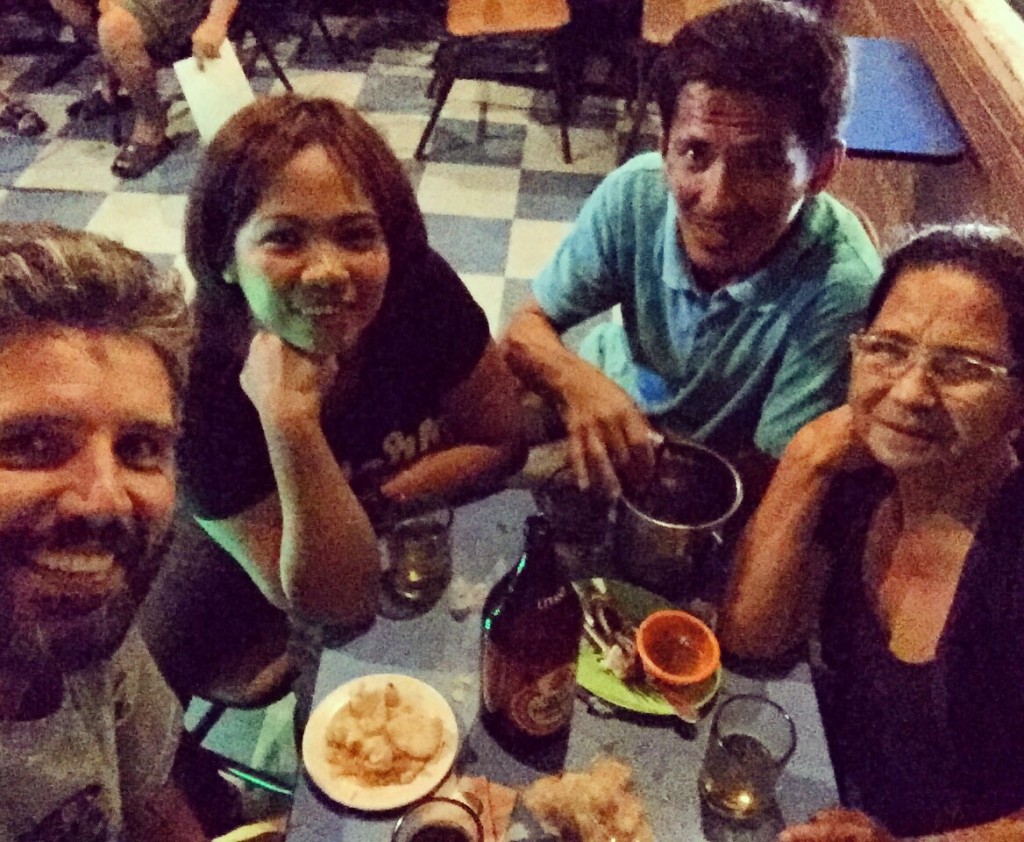
SELFIE WITH ATIVAN GANG Luís Simões, a Portuguese artist, is shown having beer with members of a gang who allegedly drugged him and divested him of his belongings. Simões managed to take this selfie with the three of the five robbery suspects using his phone. CONTRIBUTEDPHOTO
LUÍS SIMÕES, a Portuguese artist documenting his travels by sketching places and people, saw for himself how dangerous Manila could be for foreign tourists.
Among his first sketches in Manila was one of the five people who drugged him, divested him of his valuables and withdrew P40,000 from his debit card.
He even took a selfie with three of the robbers.
“I just saw a truth about Manila,” Simões told the Inquirer after lodging the complaint in the Pasay City police station.
Simões, a 36-year-old sketch artist whose plan to travel five continents in five years on a shoestring budget was widely publicized in Portugal, has fallen victim to a robbery group, called the “Ativan Gang” by the police, whose members befriend foreign tourists, and offer them food and drinks laced with drugs.
It all started at Manila Cathedral past noon on Dec. 22, 2015, where the artist met two middle-aged women.
“They said they were visiting the city. One of them asked me if I wanted to follow them in their little tour around the town. They seemed so friendly and nice. You wouldn’t suspect they had bad intentions,” Simões said.
Good vibe
The adventurous traveler accepted the invitation as an opportunity to immerse himself in the local culture. “Why not?” he said, noting he had met new friends in the last four years in his travels in 36 countries in Europe and Asia.
After the tour, the two women invited him to 199 Bar and Restaurant on Arnaiz Street in Pasay City. Another man showed up at the karaoke bar, introducing himself as a cousin of the women.
“I felt there was sympathy and a good vibe,” he said. He also noted the man kept filling his glass with beer while they sang songs on the videoke.
After paying for the P700 bill, they walked out of the bar between 8 p.m. and 9 p.m., he told investigators.
Simões, who admitted he was already drunk then, was led to a van. “Let’s have dinner,” one of the women told him.
In the van there were two other people, a man and a woman. He was told by his hosts they were visiting relatives.
They kept giving him food and drinks in the vehicle. He felt sleepy. One of the women asked where he was staying in Manila. After telling them, he passed out.
PORTRAIT OF A CON ARTIST A copy of Portuguese artist Luís Simões’ sketch of a woman, reportedly a member of the
Ativan Gang. CONTRIBUTED PHOTO
Not so gracious
He woke up at a hostel in Makati City later, with a hangover. He found out that his valuables, including the sketch he made for one of the women, and his debit card were missing. His camera and phone were not taken but the robbers tried to delete all the photos he took during his tour.
However, he recovered the photo of his sketch and a selfie he took with the suspects.
Simões immediately blocked his debit card only to find out a few days later that while he was unconscious on Dec. 22, his hosts had managed to take P40,000 from it.
“Since that day, giving trust and finding pleasure in dealing with new people had been lost,” Simões said. “Manila gave me the worst experience of easily trusting people and accepting their help in a genuine way.”
In 2012, Simões left his job as a motion designer for a TV station in Lisbon and sold all his property to embark on a five-year world travel. He had been a frugal traveler, staying in budget hostels or sleeping on friends’ couches.
Great story
In the last four years, he had produced thousands of sketches which he planned to compile into a book.
He once lost his iPad and stylus to a thief in Barcelona. But the incident in Manila was different, Simões said, because the robbers had actually gained his confidence.
Simões reported the incident to the police on Jan. 2, after he came back from traveling in the northern Philippines and learned about the debit card withdrawal.
PO3 Miko Camillo said catching members of the Ativan Gang could be difficult because the victims could not remain in the country. “If they report it, they will not longer pursue the case because they have to leave the country,” he said. Because of this, most of the cases against the Ativan Gang were often dismissed.
In the first week of December, a Spaniard, Jose Pedro Bosch, 44, lost the 600 euros (over P32,000) in cash he had in his wallet, apart from 181 euros (over P9,000) withdrawn from his debit cards.
Simões said he did not expect to get his money back. But what he wanted when he filed the complaint was for the robbers to be arrested and to serve as a warning to other foreign tourists coming to the Philippines.
“There is no desire to come back here but it is a great story to tell,” said Simões, who planned to create panels of drawings to portray his sad experience in Manila.